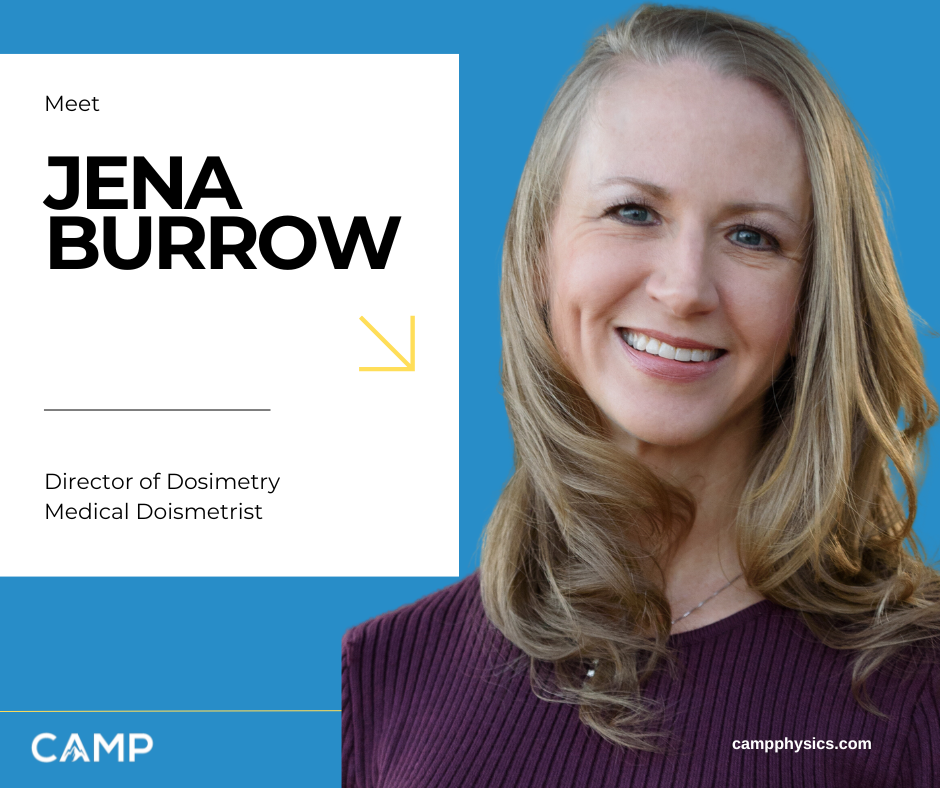A Day in the Life of a Dosimetrist: Meet Jena Burrow

Introduction
Behind every cancer treatment plan, there’s a team of experts working tirelessly to ensure patients receive the best possible care. One key member of that team is the dosimetrist, a crucial figure in radiation therapy. Today, we’re catching up with Jena Burrow, a skilled dosimetrist at CAMP, as she shares what a day in her role looks like, the challenges and rewards of her work, and what it takes to succeed in this vital profession.
Can you walk us through a typical day in your role as a dosimetrist?
When starting my day, I go over my task list, which includes patients I need to work on based on the requirements such as contouring, planning, or pending approval. In the mornings I also connect with physicians to plan out my day and discuss any upcoming plans. I prioritize those plans that need to be done sooner. Often, I am multitasking by optimizing a plan for dose while working on another plan. Multitasking helps me be an efficient planner. As CT simulations are completed, I import them and prepare them for physicians. Sometimes, urgent patients come up and require me to shift focus from my current tasks.
What are the key responsibilities of a dosimetrist during a treatment planning process?
A dosimetrist has a lot on their plate! Most think it’s just planning for a patient, but our work entails so much more. It all kicks off with the simulation. Dosimetrists assist therapists in understanding what to look out for with a good setup and an optimal CT scan. Then, they scrutinize the scan to ensure it accurately represents the patient. They make sure there’s plenty of CT image information around the target area the physician will be working on. The dosimetrist is usually the one who contours the normal tissue organs at risk (OARs) or supervises the auto-contour software performing that task. If the software does it, the dosimetrist has to double-check all the OARs on every slice for accuracy and make any necessary adjustments. It’s often up to the dosimetrist to get the secondary images needed by the physician for fusions and finish those fusion, which is overlaying two image sets together such as MRI and CT . After the physician defines their target volumes (what they want to treat with radiation), it’s the dosimetrist’s job to ensure they match the prescription and the physician’s consultation. If anything seems off or the targets don’t look right, the dosimetrist needs to clear things up before continuing with planning. They have to ensure the right type of plan is being executed based on insurance and the physician’s requests. During planning, they have to monitor all normal tissue OARs and adhere to the constraints outlined by the physician. If adjustments are needed to meet objectives, the dosimetrist must communicate with the team. Safety is key, not just in terms of OAR dose but also movement of the linear accelerator around the patient. The dosimetrist ensures the doctor reviews the plan and discusses it so the entire care team is aligned. Throughout this process, we keep in touch with the physics team and therapists to ensure a smooth plan completion. Once approved by the doctor, it’s typically the dosimetrist’s job to finalize the plan for treatment and hand it off to physics for a final check before moving on to treatment.
How do you collaborate with other members of the oncology team, such as radiation oncologists and medical physicists?
It’s absolutely critical that we have good communication within the department. We usually have daily huddles to discuss each patient’s status – whether they’re coming in for consultation, getting CT simulation, in the planning process, or currently under treatment. The physician and dosimetrist communicate in various ways, but most often it’s through a HIPAA compliant messaging platform.
What aspects of your job do you find most rewarding and why?
Medical Dosimetry is a behind the scenes job that most people are not familiar with. When I describe my job to people they find it rather intriguing. It is not only interesting, it is very rewarding. The satisfaction comes from knowing that I am creating something to help fight someone’s debilitating cancer that is unique to them. Whether it is treating the tumor to eliminate it, or just treating a lesion to get some pain relief, both I know are helping increase the quality of life for the patient. Having a very supportive team (CAMP physicists, therapists, physicians, and other supportive staff) behind me as I create those plans allows me to create those effective and efficient plans to help the patient.
What skills or qualities do you think are essential for someone in your role?
To be a dosimetrist, you need a few key qualities. Effective communication is at the top of the list. You also need to be organized, good at multitasking, and pay close attention to detail. It’s important to be open to learning new methods as new information comes out. Medical and physics knowledge is essential to one being able to understand the dynamics of dosimetry. As well as being able to apply critical thinking tactics to create radiation therapy plans that are effective and efficient.
What inspired you to pursue a career as a dosimetrist?
When I started as a radiation therapist, I was fascinated by how treatment plans could cover a tumor while avoiding critical structures. I decided after almost 10 years of being a therapist it was time for me to expand my knowledge and learn what it took to create those amazing radiation plans. I enjoyed the constant evolving of the technology to help create those effective cancer treatment plans. It’s a role that requires us to keep learning and coming up with better plans.
What advice would you give to someone considering a career in medical dosimetry?
If you’re curious about dosimetry, start by shadowing a dosimetrist! People who pursue a career as a Medical Dosimetrist usually have an idea of what the role entails. But there’s a lot of behind-the-scenes work that many don’t realize. Having some foundation of medical and physics knowledge would be ideal, even though anyone can eventually learn what all is involved with dosimetry. Being a critical thinker to help design those plans would be ideal to make some creative and conformal plans. Always open to change with the planning techniques, due to the field always advancing, is ideal. It is a requirement for a dosimetrist to stay current on the advancements.
Conclusion
Jena’s insights offer a deeper appreciation for the crucial role dosimetrists play in the fight against cancer. Her passion for the work, dedication to learning, and commitment to patient care exemplify the qualities that make a difference in the lives of so many. As advancements in medical dosimetry continue to evolve, professionals like Jena will remain at the forefront, shaping the future of cancer treatment with precision and compassion.
Connect with CAMP
Looking to connect with Jena? You can find her on LinkedIn.
Want to learn more about dosimetry, and the latest advancements in treatment planning? CAMP offers a wealth of resources and expertise to help you stay informed and engaged in this dynamic field. Whether you’re a healthcare professional, student, or simply curious about the science behind radiation therapy, CAMP is here to support your journey.
Visit our website to explore our services, discover educational opportunities, and join a community dedicated to advancing medical physics.
